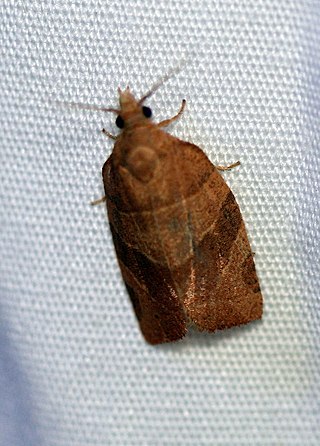
Pandemis corylana, the chequered fruit-tree tortrix, hazel tortrix moth, filbert tortricid or barred fruit tree moth, is a moth of the family Tortricidae. It is found from northern and central Europe to Siberia, Korea and Japan.

Argyrotaenia franciscana, the orange tortrix or apple skinworm, is a moth of the family Tortricidae. It is found from California north to Oregon and Washington.

Amorbia humerosana, the white-lined leafroller, is a species of moth of the family Tortricidae. It is found from the Gulf states to the northeastern United States and southeastern Canada.

Amorbia cuneanum, the western avocado leafroller moth, is a species of moth of the family Tortricidae. It is found from Baja California, Mexico, to south-western Canada. To the east, the range extends to Arizona and Idaho in the United States.

Platynota flavedana, the black-shaded platynota moth, is a species of moth of the family Tortricidae. It is found in the United States from Minnesota to Maine, south to North Carolina and west to Arizona.

Sparganothis senecionana is a species of moth of the family Tortricidae. It is found in western North America, from British Columbia to Mexico and east to Colorado.
Sparganothis tunicana is a species of moth of the family Tortricidae. It is found in North America in California, Washington, Oregon, Utah, Idaho and British Columbia.
Eupinivora thaumantias is a species of moth of the family Tortricidae. It is found in Mexico.
Eupinivora hamartopenis is a species of moth of the family Tortricidae. It is found in Durango, Mexico.

Archips mortuanus, the dusky-back leaf roller, is a species of moth of the family Tortricidae. It is found in eastern North America, where it has been recorded from Maine, Michigan and New York.

Archips purpuranus, the omnivorous leafroller moth, is a species of moth of the family Tortricidae. It is found in most of eastern North America.
Argyrotaenia quadrifasciana, the four-lined leafroller moth, four-banded leafroller or lesser all-green leafroller, is a species of moth of the family Tortricidae. It is found in North America, where it has been recorded from Nova Scotia to West Virginia, west to Arkansas and north to Alberta. The habitat consists of orchards and shrubby areas.

Clepsis persicana, the white triangle tortrix or the green needleworm, is a species of moth of the family Tortricidae. It is found in North America, where it has been recorded from Alaska and British Columbia to Newfoundland and south to Virginia and west to California. The habitat consists of coniferous and mixed coniferous forests.

Clepsis virescana, the light brown apple moth, is a species of moth of the family Tortricidae. It is found in North America, where it is widespread in southern Canada and most of the United States. The habitat consists of shrubby open areas and aspen parkland.
Spilonota albicana, the white fruit moth, larger apple fruit moth or eye-spotted bud moth, is a species of moth of the family Tortricidae. It is found in China, Korea, Japan and Russia. It has been accidentally introduced in the Netherlands.

Pandemis limitata, the three-lined leafroller, is a species of moth of the family Tortricidae. It is found in North America, where it has been recorded from Nova Scotia to British Columbia and from the east coast west to the Rocky Mountains and Arizona. It has also been recorded from Durango in Mexico.
Pandemis pyrusana, the apple pandemis or pandemis leafroller moth, is a species of moth of the family Tortricidae. The species was first described by William D. Kearfott in 1907. It is found in North America, where it has been recorded from Alberta to British Columbia, south through Idaho, Utah and Colorado and California. The habitat consists of forests with deciduous trees and shrubs.

Pandemis lamprosana, the woodgrain leafroller moth, is a species of moth of the family Tortricidae. It is found in North America, where it has been recorded from the north-eastern United States, Quebec and Ontario.

Acleris nigrolinea is a species of moth in the family Tortricidae. It is found in North America, where it has been recorded across Canada from British Columbia to New Brunswick, and in the United States as far south as California, Arizona, Tennessee and North Carolina.
Acleris minuta, the yellow-headed fireworm or lesser apple leaf-folder, is a species of moth of the family Tortricidae. It is found in eastern North America.













